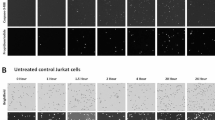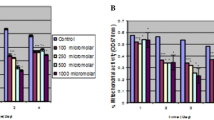Abstract
The difference of sensitivity to indole-3-acetic acid (IAA) combined with horseradish peroxidase (HRP) in K562 and BXPC-3 cells was investigated. The cell proliferation was determined by MTT assay. The cell cycle and apoptosis of K562 and BXPC-3 cells were examined by a fluorescence flow cytometer (FCM) and terminal deoxynucleotidyl transferase-mediated dUTP nick-end labeling (TUNEL) respectively. The experimental results show that IAA and HRP could inhibit BXPC-3 cell proliferation greatly compared with K562 cell during the first 48 h. The cell cycle was arrested predominantly at G2/M phase in K562 and BXPC-3 cells. The cell apoptosis of K562 and BXPC-3 was induced by IAA/HRP. There was a significant difference between the two cell lines since BXPC-3 cells were more sensitive than K562 cells by treatments with combination of IAA and HRP.
Similar content being viewed by others
References
Folkes LK and Wardman P. Oxidative Activation of Indole-3-acetic Acids to Cytotoxic Species—A Potencial New Role for Plant Auxins in Cancer Therapy[J].J. Biochemical Pharmacology, 2001, 61: 129–136
Greco O, Rossiter S, Kanthou C,et al. Horseradishperoxidase-mediated Gene Therapy Choice of Prodrugs in Oxic and Anoxic Tumor Conditions [J].J. Molecular Cancer Therapeutics, 2001, 1: 151–160
Folkes LK, Greco O, Dachs GO,et al. 5-Fluoroindole-3-acetic Acid: A Prodrug Activated by a Peroxidase with Potential for Use in Targeted Therapy [J].Biochemical Pharmscology, 2002, 63: 265–272
Rossiter S, Folkes LK and Wardman P. Halogenated Indole-3-acetic Acids as Oxidatively Activated Prodrugs with Potential for Targeted Cancer Therapy [J].Bioorganic & Medicinal Chemistry Letters, 2002, 12: 2523–2526
Folkes LK, Dennis MF, Stratford MR,et al. Peroxidase-catalyzed Effects of Indole-3-acetic Acid and Analogues on Lipid Membranes, DNA and Mammalian Cells in vitro [J].J. Biochemical Pharmacology, 1999, 57: 375–382
Folkes LK, Candeias LP, Wardman P,et al. Toward Targeted “Oxidation Therapy” of Cancer: Peroxidase-catalyzed Cytotoxicity of Indole-3-acetic Acids [J].J. Radiation Oncology Biol. Phys., 1998, 42: 917–920
Wardman P. Indole-3-acetic Acid and Horseradish Peroxidase; a New Prodrug/Enzyme Combination for Targeted Cancer Therapy [J].J. Curr. Pharm Des., 2002, 8: 1363–1374
Makin G and Dive C. Recent Advances in Understanding Apoptosis: New Therapeutic Opportunities in Cancer Chemotherapy [J].J. Trends Mol. Med., 2003, 9: 251–255
Greco O, Dachs GU, Tozer GM,et al. Mechanisms of Cytotoxicity Induced by Horseradish Peroxidase/Indole-3-acetic Acid Gene Therapy[J].J. J Cell Biochem., 2002, 87: 221–232
Kima DS, Jeonb SE and Park KC. Oxidation of indole-3-acetic Acid by Horseradish Peroxidase Induces Apoptosis in G361 Human Melanoma Cells[J].J. Cellular Signalling, 2004, 16: 81–88
De Melo MP, Pithon-Curi TC, and Curi R. Indole-3-acetic Acid Increases Glutamine Utilization by High Peroxidase Activity-presenting Leukocytes[J].J. Life Science, 2004 75: 1713–1725
De Melo MP, De Lima TM, Pithon-Curi TC,et al. The Mechanism of Indole Acetic Acid Cytotoxicity[J].J. Toxicology Letters, 2004, 148: 103–11
Pietenpol JA and Stewart ZA. Cell Cycle Checkpoint Signaling: Cell Cycle verus Apoptosis[J].J. Toxicology, 2002, 181–182: 475–481
Kim JY, Kim CH, Stratford IJ,et al. The Bioreductive Agent RH1 and Irradiation both Cause G2/M Cell Cycle Phase Arrest and Polyploidy in a p53-mutated Human Breast Cancer Cell Line[J].J. Radiation Oncology Biol. Phys., 2004, 58: 376–385
Armstrong JS, Hornung B, Lecane P,et al. Rotenone-induced G2/M Cell Cycle Arrest and Apoptosis in a Human B Lymphoma Cell Line PW[J].J. Biochemical and Biophysical Research Communications, 2001, 289(5): 973–978
Author information
Authors and Affiliations
Corresponding author
Additional information
Funded by the National Natural Science Foundation of China (No. 30170011), the Construction Fund for “211” Project of the Ministry of Education of China and the Natural Science Foundation of Hubei Province (No. 2006ABA197)
Rights and permissions
About this article
Cite this article
Yali, B., Deli, L., Dali, Z. et al. The difference of sensitivity between BXPC-3 and K562 cells by treatments with combination of indole-3-acetic acid and horseradish peroxidase. J. Wuhan Univ. Technol.-Mat. Sci. Edit. 21, 95–98 (2006). https://doi.org/10.1007/BF02841214
Received:
Accepted:
Issue Date:
DOI: https://doi.org/10.1007/BF02841214




